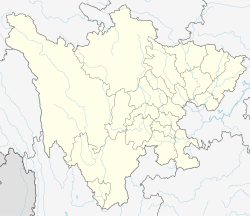Top Qs
Timeline
Chat
Perspective
Barkam
County-level city in Sichuan, China From Wikipedia, the free encyclopedia
Remove ads
Barkam or Markang or Muerkvua is a county-level city in Ngawa Tibetan and Qiang Autonomous Prefecture, in the northwest of Sichuan province, China. The city seat is the town of Barkam.[2][3] As of the 2010 Chinese Census, Barkam has a population of 58,437.[2]
Remove ads
Toponymy
Barkam comes from the Tibetan "place of strong fire" and, by extension, "place of prosperity".[2]
History
Summarize
Perspective
Historically, Barkam belonged to the Somang Tusi (Chinese: 梭磨土司; pinyin: Suōmó Tǔsī), one of the Gyalrong Tusi.[2] The area was administered as three units: Zhuokeji (Chinese: 卓克基; pinyin: Zhuōkèjī), Zonggag (Chinese: 松岗; pinyin: Sōnggǎng), and Tamba (Chinese: 党坝; pinyin: Dǎngbà).[2]
During the Qin dynasty, the area belonged to Jiandi Dao.[4] It belonged to Wenshan Commandery during the Han dynasty.[4] During the Tang and Song dynasties, the area was part of the Jimi system.[4] The area was governed by the Bureau of Buddhist and Tibetan Affairs during the Yuan dynasty.[4] During the reign of the Yongle Emperor during the Ming dynasty, the area belonged to the Zagu Tusi.[4] During the reign of the Qianlong Emperor of the Qing dynasty, the area was brought under the control of the Lifan Ting.[4] Under the subsequent Jiaqing Emperor, the area was reorganized as the Zagu Ting.[4]
During the Republic of China, the area was organized as Lifan County (Chinese: 理番县; pinyin: Lǐfān Xiàn).[4]
People's Republic of China
In December 1950, officials from nearby Mao County embarked on a mission to establish temporary governing committees in the area of present-day Barkam.[4] The People's Republic of China established control of the area in August 1951.[4] In September 1951, the area was incorporated as the Situ Aba Provisional Military Government Committee (Chinese: 四土阿坝临时军政委员会; pinyin: Sìtǔ Ābà Línshí Jūnzhèng Wěiyuánhuì).[2][4] In April 1953, Barkam was organized as the Barkam Office (Chinese: 马尔康办事处; pinyin: Mǎ'ěrkāng Bànshìchù).[2][4] Barkam was reorganized as a county on April 21, 1956.[4]
In 1957, the areas of Sizhai (Chinese: 四寨), Rangkou (Chinese: 壤口), and Longri (Chinese: 龙日) were moved from Barkam County to nearby Hongyuan County.[2]
In November 2015, the State Council agreed to reorganize Barkam as a county-level city.[2][4]
On December 18, 2019, the Department of Civil Affairs of Sichuan Province approved the merger of the now-defunct town of Zhuokeji into the town of Barkam.[5]
Remove ads
Geography
Summarize
Perspective
Barkam is located within the southwest portion of Ngawa Tibetan and Qiang Autonomous Prefecture, in northwest Sichuan.[3] The city is located on the southern edge of the Northwest Sichuan Plateau.[3] Major rivers that flow through Barkam include the Somang River, the Chabao River (Chinese: 茶堡河; pinyin: Chábǎo Hé), and the Gyomgyo River.[3] Barkam's canyons are densely forested, with major tree genus's including fir, spruce, larch, birch, and oak.[6] Quercus semecarpifolia, a species of oak tree, is present in Barkam.[6]
Fauna
The forests in the mountains are home to various protected animals such as leopards, Thorold's deer, sika deer, takin, and various birds.[6]
Climate
Due to its elevation, Barkam lies in the transition between a subtropical highland climate (Köppen Cwb) and humid continental climate (Köppen Dwb), with strong monsoonal influences; winters are frosty and summers warm with frequent rain. The monthly 24-hour average temperature ranges from −0.5 °C (31.1 °F) in December and January to 16.4 °C (61.5 °F) in July, while the annual mean is 8.75 °C (47.7 °F). Nearly two-thirds of the annual precipitation of 784 mm (30.9 in) occurs from June to September. With monthly percent possible sunshine ranging from 36% in June to 65% in December, the town receives 2,133 hours of bright sunshine annually. Diurnal temperature variation is large, averaging 16.0 °C (28.8 °F) annually.
Remove ads
Administrative divisions
Summarize
Perspective
Barkam administers the following three towns and 10 townships:[10]
Remove ads
Demographics
As of the 2010 Chinese Census, Barkam has a population of 58,437.[2] This represents an increase from the 55,046 recorded in the 2000 Chinese Census.[2] Barkam had a population of 54,735 in 1999.[12] In 1996, Barkam had an estimated population of 54,000.[2]
As of 2016 government figures, 77.41% of Barkam is classified as ethnically Tibetan, while 18.09% is ethnically Han Chinese, 2.97% is ethnically Qiang, 1.20% is ethnically Hui, and the remaining 0.34% belong to other ethnic groups.[13]
The area is traditionally inhabited by a branch of Rgyalrong people who speak the Situ language.[14] Chagpar Township hosts a unique dialect of Situ.[15]
Remove ads
Economy
As of 2021, Barkam has a gross domestic product (GDP) of about 4.6 billion renminbi (RMB).[16] This represents an approximate 70% increase from 2016.[16] GDP per capita as of 2021 was approximately 78,000 RMB, also a 70% increase from 2016.[16]
Barkam is home to over 1,300 ingredients used in traditional Chinese medicine, including many derived from local deer, bears, cattle, fungus, and lilies.[6]
Remove ads
Transport
- China National Highway 317[3]
- Sichuan Provincial Highway 210[3]
Tourism
Major historical sites in Barkam include:
- Zhuokeji Tusi Official Village[3]
- Codün Temple[3]
- Zonggag Zhibo Stone Blockhouse Group (Chinese: 松岗直波石碉群; pinyin: Sōnggǎng Zhíbō Shí Diāo Qún)[3]
- Red Army Slogan Stone Inscription (Chinese: 红军标语石刻; pinyin: Hóngjūn Biāoyǔ Shíkè)[3]
- Zhuomu Blockhouse Meeting Site (Chinese: 卓木碉会址; pinyin: Zhuōmù Diāo Huì Zhǐ)[3]
Notes
External links
Wikiwand - on
Seamless Wikipedia browsing. On steroids.
Remove ads




